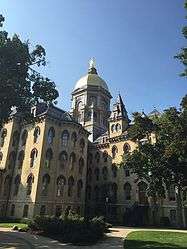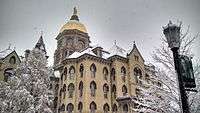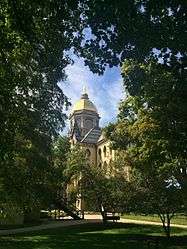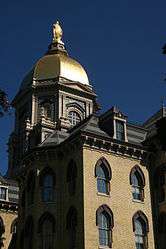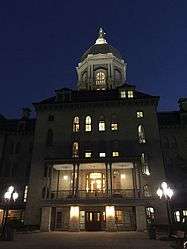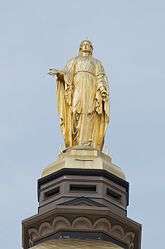The University of Notre Dame's Main Administration Building (known as the Main Building or the "Golden Dome") houses various administrative offices, including the Office of the President.[2] Atop of the building stands the Golden Dome, the most recognizable landmark of the University.[3]
History
The first main building was started on August 28th 1843, shortly the architect Mr. Marsile arrived on campus on the 24th. it was complete by the fall of 1844. It was a brick building, 4 1/2 story high with a small cupola (not yet a dome) with a bell in it, in French style.
Construction of the second Main Building, which replaced the first, began in 1864 and was completed in 1865. It was to be 160 feet long, 80 feet wide, and 90 feet high; it was six stories high and had a dome at the top. The architect was Mr. Thomas from Chicago, and most of the workers who built it were brothers of the Congregation of Holy Cross. Classes were taught on the third floor, while the fourth and fifth floors were dormitories. The building stood for 14 years before being destroyed by a great fire on April 23, 1879. The entire building was destroyed, but the nearby church was spared. The school closed immediately and students were sent home.

The Main Administration with the Golden Dome building in the Fall
University founder Rev. Edward Sorin and the president at the time Rev. William Corby immediately planned for the rebuilding of the structure that had housed virtually the entire University. Donations for the rebuilding of the college came from alumni, people of Saint Mary's College, South Bend, and Chicago.
"By all means we must bring upon these new foundations the richest blessings of Heaven, that the grand edifice we contemplate erecting may remain for ages to come a monument to Catholicism, and a stronghold which no destructive element can ever shake on its basis or bring down again from its majestic stand.[4] The University took action by selecting a new design by Willoughby J. Edbrooke and commencing construction on the 17th of May. The construction was very rapid due to the zeal of workers and volounteers. By June 21st the first story was completed, and by June 28th they completed the second. the fouth of July saw the completion of the third. The building was completed before the fall semester of 1879. Fifty-six bricklayers and 4,350,000 bricks were necessary to complete it, and once finished it stood 187 feet tall.[5] The halls were wide and it was considered hygenic, since they had installed a ventilating system unequalled in any public building in America at the time.
The Golden Dome was the last thing to be finished, with the iron framework, the panels and the columns supporting the dome, being added during the summer of 1882 and the dome itself was finished in September. The statue of Mary was hoisted in October. It was a gift from the sisters of adjacent Saint Mary's College, Notre Dame's sister school.[6] It was gilded in 1886 and crowned with a 19 feet tall statue of "Our Mother", the namesake of the university. The statue was designed and furnished by the girls of the nearby St. Mary's College, and it is a replica of the statue of Mary in the Piazza di Spagna in Rome, erected by Pius IX. It was designed by Chicago artist Giovanni Meli.[7] The dome was last re-gilded in 2005.
Interior
The building is the location of many administrative offices of the university including that of the President, Office of Admissions, and various other offices and services of the University. Additionally, it has classrooms and meeting rooms.
The halls are decorated by portraits of the presidents of the university. The lower level hosts a gallery dedicated to the Laetare Medal awardees and the Wall of Honor adorned by plaques dedicated to notable people awarded for their service to the University. The building also houses the Columbus Murals, a group of large paintings by Italian painter and Notre Dame professor Luigi Gregori, depicting the discovery of the New World by Christopher Columbus. Gregori also painted with figures representing Religion, Philosophy, Science, History, Fame, Poetry and Music the interior of the Golden Dome, the University's most recognizable landmark.[8][9]

Interior of the Golden Dome
Steps Tradition and Superstition
In campus lore, if a student ascended the front steps of the Main Building before graduation, that student was doomed never to graduate. This legend stems from traditionalist smoking rituals. Students were not deemed worthy to climb the steps and smoke with their professors until they received their degrees and were educational equals.[10]
Gallery
| Main Building and the Golden Dome |
|---|
| Main building seen from Main Quad |
| The Main Building in winter |
| Close up of the Golden Dome |
|
References
- 1 2 "Official Building Inventory" (PDF). Facilities Design and Operations. University of Notre Dame. 1 October 2015. Retrieved 11 November 2015.
- ↑ University of Notre Dame, Sights and Sounds: Main Building, http://www.nd.edu/campus-and-community/sights-sounds/virtual-tour/
- ↑ http://articles.chicagotribune.com/2004-09-26/travel/0409250216_1_edward-sorin-campus-golden-dome
- ↑ Circular Letter No. 96 from Fr. Sorin to the Holy Cross Community, May 23, 1879. http://www.archives.nd.edu/circulars/CLO1-1879-05-01.pdf
- ↑ University of Notre Dame, Notre Dame Archives, http://archives.nd.edu/main.htm
- ↑ University of Notre Dame, Sights and Sounds: Golden Dome, http://nd.edu/campus-and-community/sights-sounds/virtual-tour/main-building-int/#tour-nav
- ↑ http://archives.nd.edu/hope/hope13.htm
- ↑ http://articles.chicagotribune.com/2004-09-26/travel/0409250216_1_edward-sorin-campus-golden-dome
- ↑ http://www.conradschmitt.com/portfolio/projects/?projectID=28
- ↑ Schlereth, Thomas, A Dome of Learning
|
|---|
| | Schools and Colleges | | |
|---|
| | Academics | |
|---|
| | Campus buildings | |
|---|
| | Residence Halls | |
|---|
| | Athletics | |
|---|
| | Culture and the arts | |
|---|
| | Related topics | |
|---|
| | Key people | |
|---|
|
External Sources



